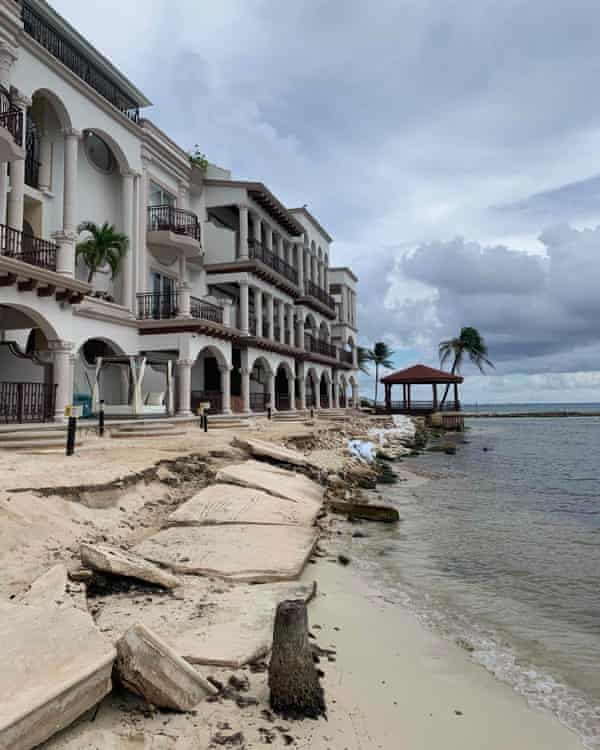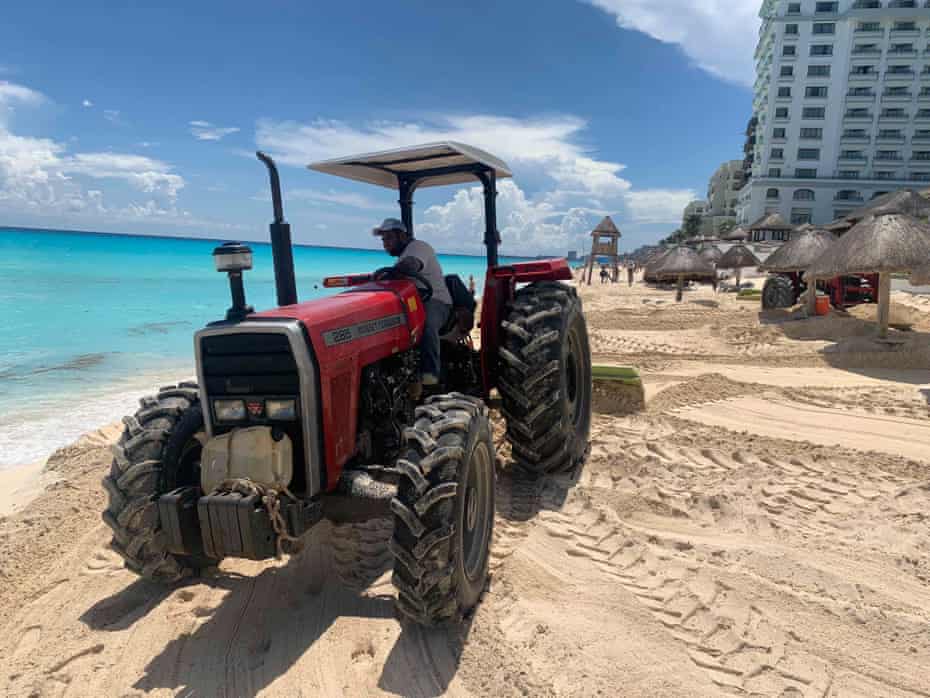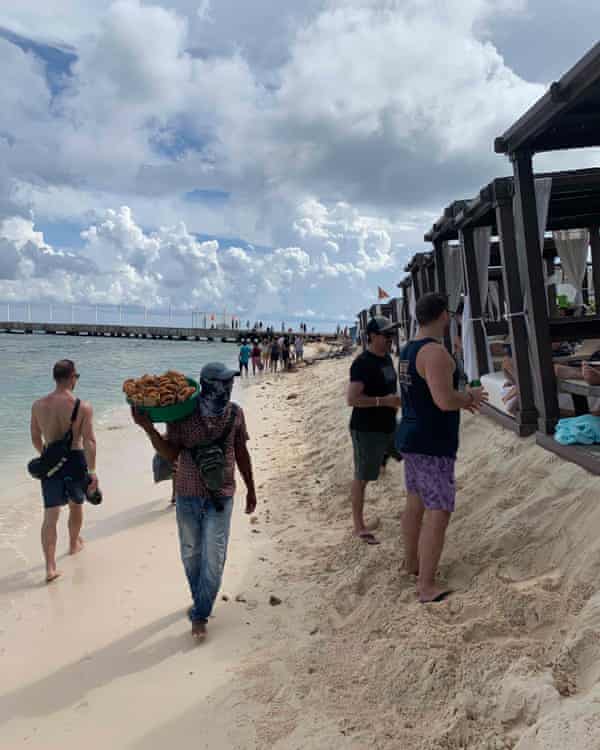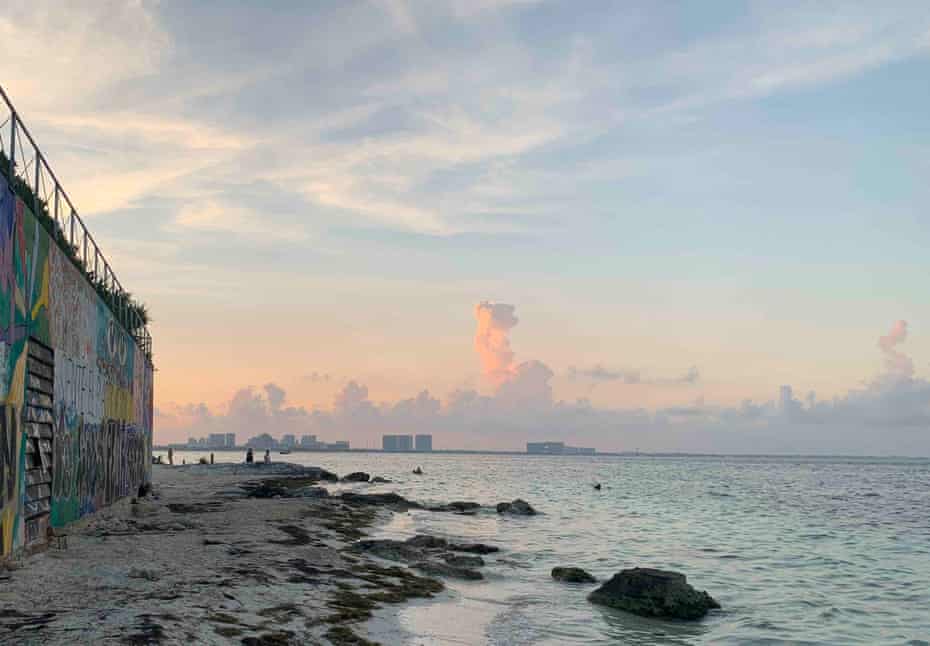[ad_1]
José Escalante looks out over the mile of fine, white sand leading up to the Mayan ruins perched on a bluff over the turquoise Caribbean. A few fishing boats have been pulled up on Tulum’s Playa Pescadores, one of the world’s most photogenic beaches. Tourists pose as the sun fades over the Yucatán peninsula behind them. All seems well in paradise.
But Escalante is weary. He is selling the six beachfront hotels he co-owns in this booming Mexican tourist destination and has a long list of reasons why: the increasingly unmanageable quantities of seaweed washing up on the beach, the large chains with few local connections opening restaurants and beach bars, and organised crime, which makes security a worry.
He also has a bigger, existential concern. “Climate change is definitely one of the reasons I am selling,” he says.
Almost all the infrastructure in Quintana Roo state is concentrated in a coastal ribbon of beach resorts and timeshare properties, especially from Tulum to Cancún, about 80 miles (130km) to the north. Air-conditioned white minivans filled with tourists buzz over hot asphalt as palms stand by on parade. But this land is in a perilous position.
Rises in sea level driven by the climate crisis could reach 40cm (15in) by 2050, says Ruth Cerezo-Mota, an oceanographer at the National Autonomous University of Mexico (UNAM), with four to 20 metres of beach lost. This “would mean chaos”, says Christian Appendini, a coastal engineer at UNAM. “All the beaches in front of urban developments would probably disappear unless drastic nature-based beach restoration measures are taken.”
The 700-mile coast of Quintana Roo has been eroded at a rate of 1.2 metres a year, with some parts losing up to 4.9 metres a year, according to Mexico’s tourism ministry.

Beaches are disappearing, and some are only maintained artificially with sand dredged from the seabed. Often they are little more than strips of sand, no wider than a dirt road. Sometimes the strand has completely vanished, leaving waves breaking against the walls of swimming pools, restaurants and houses.
Hurricanes are expected to increase in intensity due to higher ocean temperatures, leading to storm surges and exacerbating beach erosion. In 2005, Cancún lost large swaths of an eight-mile beach after Hurricane Wilma, which were later artificially restored, and then hit again by Hurricane Dean two years later. In 2020, the Riviera Maya region experienced 17 tropical storms and 13 hurricanes in one of the most active hurricane seasons on record.
Algal blooms have also plagued the coast of the Riviera Maya, a phenomenon scientists have linked to warming sea temperatures. The beachfront along the coast is frequently lined with mounds of rotting black seaweed. In Tulum, the seaweed is often stacked high in piles with workers shovelling it on to wheelbarrows on the shore and hotel owners despairing over where to put it all.
Yet as the region starts to rebound from the pandemic – about 12.5 million tourists visited Quintana Roo last year – experts say few are thinking about the climate crisis.

Last year, the Mexican president, Andrés Manuel López Obrador, announced the construction of a new international airport in Tulum and the huge Tren Maya rail project will further accelerate development. At least 91 big tourist projects are under construction in the state, according to the Mexican environmental watchdog Bios Política.
Quintana Roo’s second largest city, Playa del Carmen, grew from a population of 63,000 in 2000 to 333,000 in 2020, the Mexican census found. It is the fastest growth rate of any municipality in Latin America, according to the city government.

This development is worsening the region’s problems, Escalante says: “I think the way hotels are built has probably contributed more to the loss of the beaches than sea level rise.” Resorts have been built on the dunes, cutting the process of beach formation in a phenomenon known as coastal squeeze.
Gene Towle, of the Mexican property consultancy Softec, says: “The real-estate market in the Cancún-Riviera Maya region is not very sophisticated – nobody is thinking long term or about climate change.

“I think there is a window of about three years before developers start feeling the economic effects of environmental degradation,” says Jennifer Ruiz-Ramírez, an oceanographer at the University of Quintana Roo. “That is how long it will take for tourists to figure out that the reality no longer corresponds to the image they are being sold.”
There are some signs that the reality of the climate crisis may be slowly dawning on parts of the Riviera Maya tourism industry. In 2019, the Quintana Roo government entered into the world’s first coral reef insurance policy with premiums paid by hotel owners as well as the local government. The first payout of $800,000 (£590,000) came in 2020 after Hurricane Delta damaged reefs and beaches.
International action could also affect the industry. In June 2021, the G7 group of rich democracies backed the mandatory reporting of climate-related financial risks by publicly traded companies. This would make beachfront investments a potential liability. In Cancún, 22 resorts are projected to experience partial flooding every year by 2050, says Daniel Scott, a geographer at Canada’s University of Waterloo.
“It could take about three years before the decision by the G7 is implemented,” says Scott. “But when that happens institutional investors will start selling high-risk properties on the coast.”
Escalante could be the first of many seeking to sell their investments while the market still has its dazzle. He does not expect to have much trouble selling his hotels during the present boom – he has never had less than full occupancy in Tulum’s tourist season.
“It was a truly great business,” says Escalante. But the writing is on the wall, he feels: “I was in Cancún recently and the beaches were just like they were after Hurricane Wilma 15 years ago.”
The reporting on this story was enabled by the Netherlands’ Steunfonds Freelance Journalistiek.

[ad_2]
Source link













